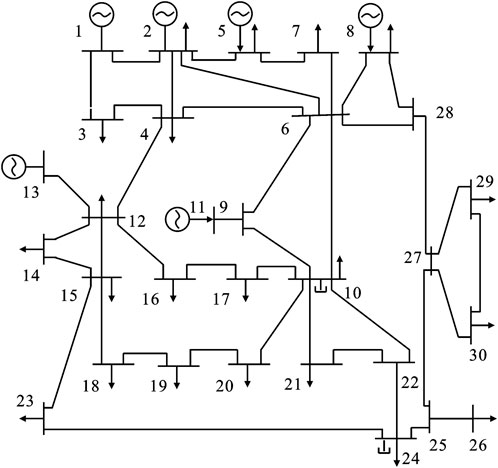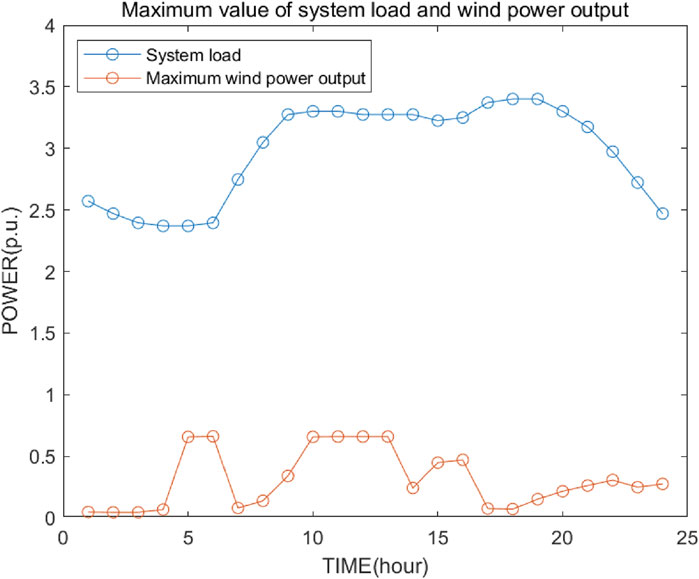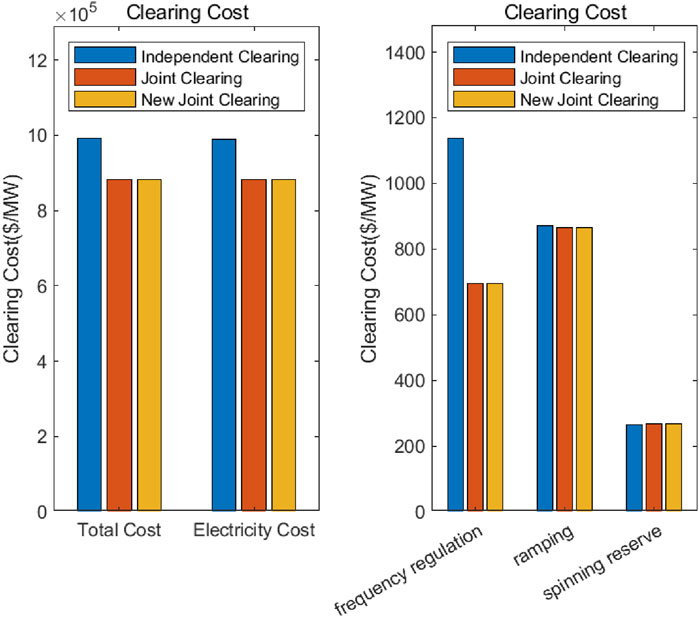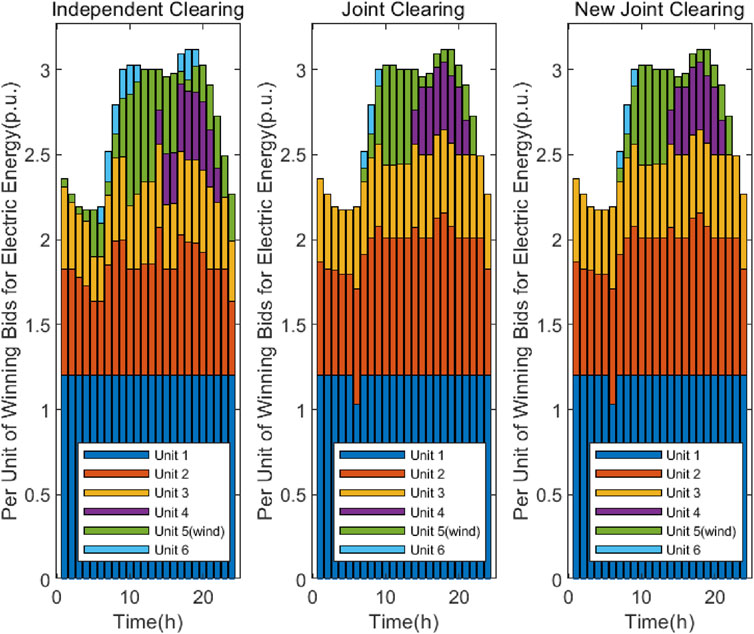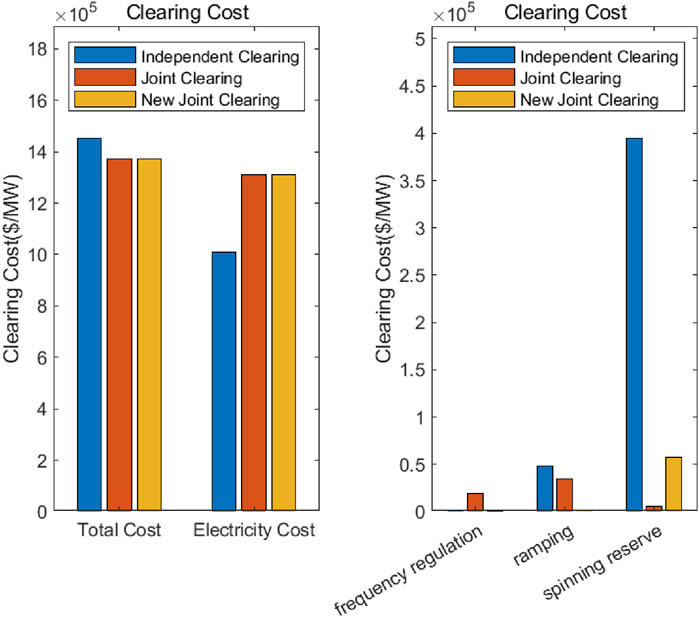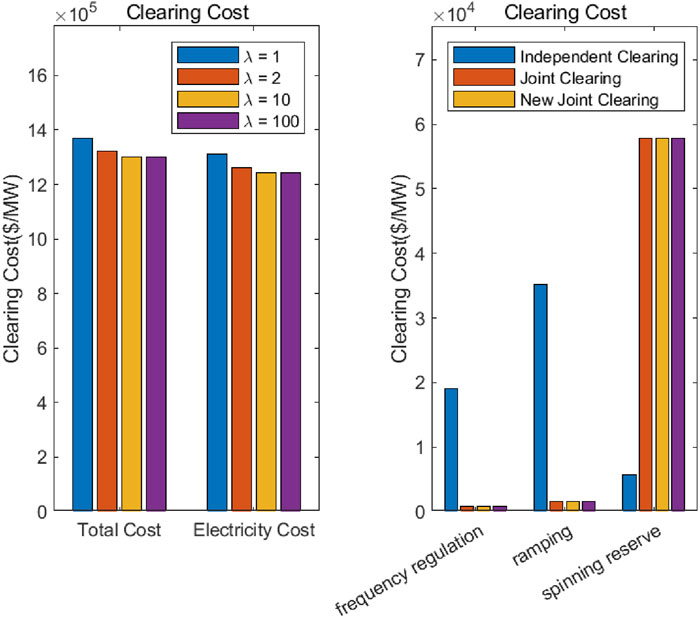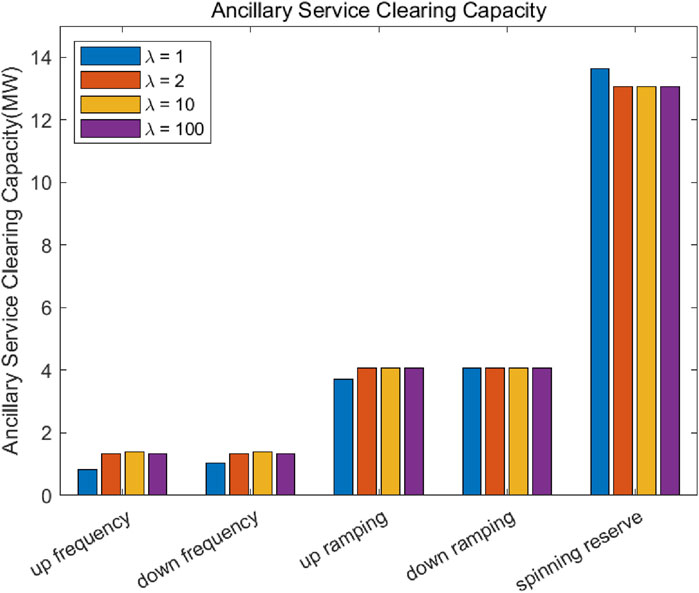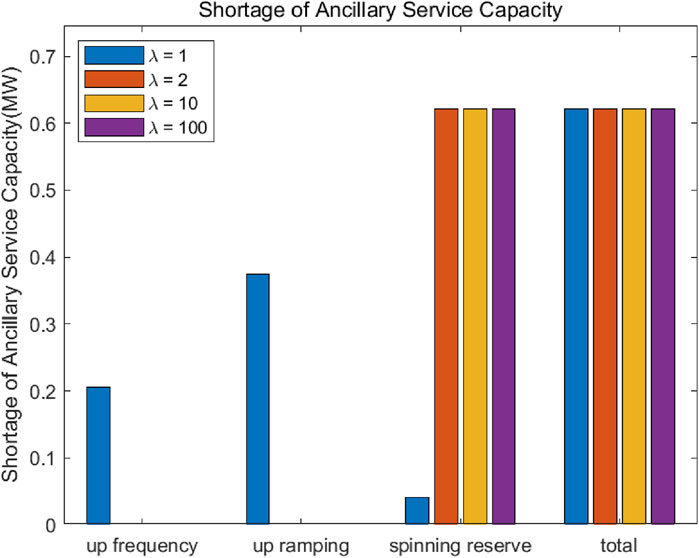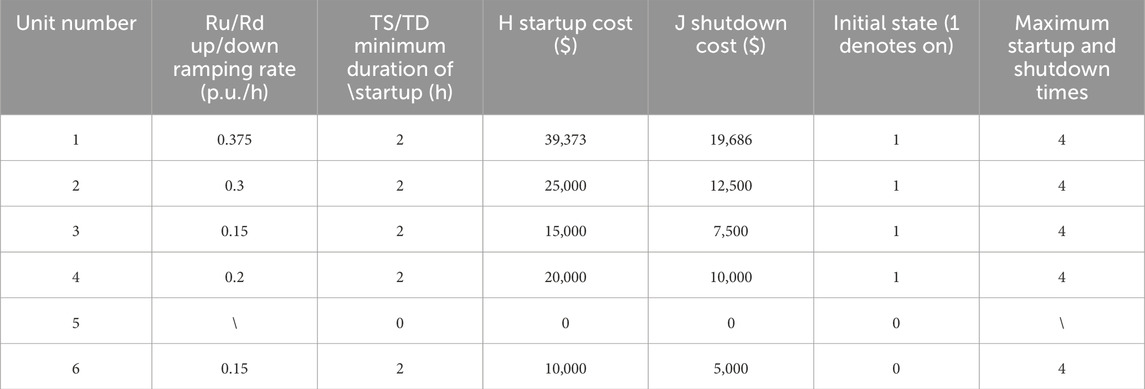- 1Power Dispatching Control Center of Guangxi Power Grid Co., Ltd., Nanning, China
- 2Department of Electrical Engineering, Wuhan Institute of New Energy, Wuhan, China
Introduction: With the large-scale grid integration of renewable sources and the increasing number of new types of loads, the demand for ancillary services in the power system has been growing rapidly. Coordinated operation between the electric energy market and the ancillary service market has become a key research topic. Traditional independent and joint clearing mechanisms each have limitations under different resource conditions.
Methods: This paper proposes a novel joint clearing model that incorporates the weights of ancillary services. The model is constructed based on security-constrained unit commitment (SCUC) and security-constrained economic dispatch (SCED), integrating electric energy and ancillary services (frequency regulation, ramping, and spinning reserve) into a unified optimization framework. A penalty-weight mechanism is introduced to dynamically adjust the clearing priority of each ancillary service.
Results: Using the IEEE-30 bus system as a test case, comparative simulations were conducted under scenarios of resource abundance and scarcity. The results show that the proposed model achieves significant cost reduction and more targeted ancillary service allocation compared with traditional independent and joint clearing models.
Discussion: The proposed clearing mechanism retains the global efficiency of joint clearing and the dispatch priority of independent clearing by incorporating ancillary service weights. It demonstrates adaptability to different resource conditions and enhances system flexibility and reliability. This model provides a promising solution for future power systems with high renewable penetration.
1 Introduction
With the large-scale grid integration of renewable sources (e.g., solar and wind), the structure of the power system is undergoing profound changes. These renewable energy sources have posed new challenges to the stable operation of the power grid due to their intermittent and uncertain characteristics. To ensure the reliability of power supply and grid balance, the demand for system ancillary services has increased significantly. These services include frequency regulation, ramping, and spinning reserve, which are essential for maintaining grid voltage stability and frequency control (Wang et al., 2022).
In order to effectively cope with the challenges brought about by the large-scale integration of renewable sources into the grid and ensure the safe and stable operation of the power system, the establishment of a market for ancillary services in the power system has become an important initiative. The market is designed to guide and incentivize various types of power resources to provide necessary ancillary services, such as frequency regulation, ramping, and spinning reserve, through market mechanisms. Through these services, grid supply and demand can be effectively balanced, and the flexibility and reliability of the power system can be improved.
Independent clearing is an important mechanism in the electricity trading market. Independent clearing refers to the separate optimization and clearing of electric energy and various ancillary services. Under the independent clearing mechanism, operators in the electric energy market independently match the supply and demand of electric energy and ancillary services and determine the prices to achieve balance and maximize the benefits of their respective markets.
Joint clearing is an important mechanism that corresponds to independent clearing in the electricity trading market. Joint clearing refers to the optimization and clearing of electric energy and ancillary services as a whole. Under the joint clearing mechanism, the operator of the electricity market will consider the supply and demand of electric energy and ancillary services and determine the optimal combination of electric energy and ancillary services through the optimization algorithm to maximize the overall efficiency of the electricity market. The spot market for electric energy and the market for ancillary services are coupled in the clearing process in terms of generation capacity. Under the premise of sufficiently transparent information and sufficient market resources, compared with independent clearing, the joint clearing of the electric energy market and ancillary service market can obtain better overall economic efficiency (Nosair and Bouffard, 2017) (Zhang et al., 2021). At the same time, joint clearing can also better protect the security and stability of the power system (Zou, 2020).
There have been many in-depth studies on joint clearing. Csereklyei et al. (2019) and Walawalkar et al. (2008) reviewed the Australian, PJM, and Nordic electricity markets and analyzed their market clearing mechanisms. Pan. Mengqi (2020) established the market mechanism of joint clearing of multiple ancillary services but did not consider the connection between the electric energy market and the ancillary service market. Wu et al. (2023) proposed a joint clearing of electric energy and frequency regulation ancillary services in wind power application scenarios, which takes into account the uncertainty of wind power output, but they did not conduct an in-depth study of the joint clearing mechanism. Xuan et al. (2019) proposed a clearing method of joint clearing of electric energy and reserve ancillary service under flexible load. Jiang et al., (2020) analyzed the cost of wind power generation under the electric energy market and the frequency regulation and reserve ancillary service market and proposed a computationally efficient joint clearing model that can be applied to the spot market containing wind turbines. Dai et al. (2023) proposed an optimization model for joint clearing of power and reserve to improve the efficiency of market clearing. Ding et al. (2021) established a mathematical model for joint optimization of power spot and deep peaking regulation market clearing based on the combination of multi-day rolling units by combining the characteristics of the Shanxi power grid in China and the policy background. Chen et al. (2021) proposed a flexible ramping ancillary service based on ramping capacity calibration. Zhang et al. (2022) established a joint clearing model of the day-ahead electric energy market and deep peaking regulation service market, which solves the problem of integration of day-ahead electric energy trading and deep peaking regulation trading. Jialong et al. (2019) proposed the design of a power day-ahead market mechanism considering deep peaking regulation and developed a market mechanism based on deep peaking regulation offers and curtailment reduction avoidance; this approach addresses the problem of accounting for unit climbing constraints in the case of the two market cut-offs. Liu et al. (2025) systematically researched and analyzed the applicable conditions of independent clearing and joint clearing.
Some studies in the literature have examined the joint clearing mechanism of the electric energy market and multiple ancillary service markets. Lv June (2022) established a day-ahead model of joint clearing of the electric energy market, frequency regulation, and reserve ancillary service market and established a model of joint clearing optimization of the electric, heat, and gas joint energy market on this basis. Dongsheng et al. (2019) established a joint optimization model of spot, frequency regulation, and reserve markets with multi-energy participation. Chen (2016) carried out an in-depth study on the application of electric storage energy to participate in peak and frequency regulation ancillary services.
However, in a situation where market resources are extremely scarce and unable to meet all demands, the traditional joint clearing mechanism often struggles to ensure priority dispatch of electric energy and key ancillary services—unlike, the independent clearing mechanism, which can effectively achieve this purpose. The Table 1 compares the characteristics of the two clearing models.
Aiming at the advantages and disadvantages of each of the two clearing methods, this paper innovatively designs a new joint clearing scheme that considers the weights of ancillary services. This scheme skillfully combines the advantages of the two clearing methods mentioned and sets corresponding clearing weights for different ancillary services based on the traditional joint clearing mechanism. This innovative approach not only retains the superiority of joint clearing in terms of overall efficiency but also skillfully draws on the characteristics of independent clearing to achieve a high degree of targeting and effectiveness in resource allocation. The new joint clearing method proposed in the paper integrates the electric energy and ancillary service markets into a unified optimization framework by introducing the ancillary service weighting parameter, and it is compatible with renewable access and ancillary service resource abundance/scarcity scenarios based on the security-constrained unit commitment (SCUC) and security-constrained economic dispatch (SCED) models. The methodology provides new ideas for a new type of power system, which needs to be implemented to dynamically adjust the weight values to match the ancillary service value, optimize the clearing priority, and expand the adaptability of multiple scenarios such as energy storage while taking into account the market flexibility and system security.
The remainder of the paper is organized as follows: Section 2 introduces the market clearing declaration requirements, Section 3 presents the clearing models for independent clearing and traditional joint clearing, Section 4 provides the clearing model for joint clearing considering the weights of ancillary services, Section 5 shows the analysis of the arithmetic examples, and Section 6 provides the conclusion of this study.
2 Market declaration requirements for electric energy and multiple ancillary services
2.1 Participants
This paper focuses on the joint clearing and optimization operation mechanism of the spot market environment with frequency regulation, spinning reserve, and ramping ancillary service markets. Considering the differences in the operating characteristics of traditional and renewable units, it is stipulated that renewable units can only be declared to participate in the spot energy market, while traditional thermal generating units can be declared to participate in the spot energy market, frequency regulation ancillary service market, spinning reserve ancillary service market, and ramping ancillary service market, but units providing ancillary services should pass the relevant tests and meet the performance index requirements for the corresponding ancillary services. However, the units providing ancillary services should pass relevant tests and meet the performance index requirements for the corresponding ancillary services.
2.2 Trade and declaration
The information declared by the generating unit in the day-ahead energy market consists of the startup costs, the costs of operation at the minimum stabilized technical output, and the offer curve. The offer curve corresponds to the price per unit of energy when the unit is operated at different output intervals and can be declared in a maximum of four segments. The offer curve must be monotonically non-decreasing with increasing output, and the price of energy offered in each segment must not exceed the upper and lower limits of the declared price.
The ancillary service market set in this paper includes the frequency regulation ancillary service market, the spinning reserve ancillary service market, and the ramping ancillary service market. Among them, frequency regulation ancillary services are divided into two categories: upward frequency and downward frequency; spinning reserve ancillary services form a single category; and ramping ancillary services are also divided into two categories: up-ramping and down-ramping. Thus, there are a total of five categories of different ancillary service products that can be declared by generator sets. Generator sets need to make independent single-segment volume and price declarations for each type of ancillary service product, and the quotation for each type of ancillary service product cannot exceed the upper and lower limits of the declared price.
3 Clearing models for independent clearing and traditional joint clearing
The clearing models mainly include the SCUC and the SCED models.
3.1 SCUC model for independent clearing and traditional joint clearing
The constraints are similar for the two clearing methods.
(1) System load balance constraints
The system load balance constraint for time period t can be described as follows:
(2) Positive and negative system reserve capacity constraints
In order to ensure stable system operation, it is generally required to reserve a certain amount of power capacity for backup in power generation measurement.
The system positive reserve capacity constraint can be described as follows:
The system negative reserve capacity constraint can be described as follows:
(3) System spinning reserve demand constraints
The winning spinning reserve capacity of all units for each time period
(4) System upward and downward frequency regulation demand constraints
The winning upward and downward frequency regulation capacities of all units for each time period
(5) System up- and down-ramping demand constraints
The up- and down-ramping capacities of all units for each time period
(6) Unit climbing rate constraints
The climbing rate constraints of the unit
(7) Constraints on the minimum continuous startup and shutdown time of the units
The minimum continuous startup and shutdown constraints for unit
(8) Constraints on the number of starts and stops of the units
The number of start and stop constraints for each unit is defined in Equations 13, 14.
(9) Unit capacity coupling constraints in the joint clearing model
The coupling constraints in joint clearing are expressed in Equations 15, 16, ensuring that the unit’s energy and ancillary service capacities remain within operational limits.
(10) Unit capacity coupling constraints in the independent clearing model
Equations 17–22 define the capacity coupling constraints for independent clearing. The constraints on the unit's output when clearing electric energy can be described as follows:
The constraints on the unit’s frequency regulation capacity when clearing frequency regulation can be described as follows:
The constraints on the unit’s ramping capacity when clearing ramping can be described as follows:
The constraints on the unit’s spinning reserve capacity when clearing spinning reserve can be described as follows:
(11) Equation 23 ensures that the same unit cannot be simultaneously awarded both upward and downward frequency regulation service.
(12) Equation 24 ensures that the same unit cannot be simultaneously awarded both upward and downward ramping service.
The constraints in Equations 1–8, 11, 12 are jointly required for both independent clearing and traditional joint clearing. The constraint in Equation 9 is specific to traditional joint clearing, and the constraint in Equation 10 is specific to independent clearing.
Independent clearing is in a sequence, so its constraints are not used simultaneously. Assuming that the clearing sequence of independent clearing is electric energy, frequency regulation ancillary service, ramping ancillary service, and spinning reserve ancillary service, when independent clearing SCUC clears the market for electric energy, it is subject to constraints provided in Equations 1, 2, 6–8; when clearing the market for frequency regulation ancillary service, it is subject to constraints provided in Equation 3; and when clearing the market for ramping and spinning reserve ancillary services, it is subject to constraints provided in Equations 4, 5. The corresponding clearing coupling constraints Equations 9 are also considered when clearing each market.
SCUC for independent clearing has multiple objective functions, each corresponding to a specific market it clears. The SCUC objective functions for independent clearing are formulated in Equations 25-28.
(1) The cost of electric energy for a unit consists of three components: operating costs, startup costs, and minimum technical output costs. The objective function of the electric energy market is as follows:
(2) The objective function of the frequency regulation market is as follows:
(3) The objective function of the ramping market is as follows:
(4) The objective function of the spinning reserve market objective function is as follows:
SCUC for traditional joint clearing has only one objective function. The SCUC objective functions for traditional joint clearing are formulated in Equation 29
3.2 SCED for independent clearing and traditional joint clearing
After SCUC clearing, the state variables of the units are determined. The SCED constraints are provided in Equations 1, 3–6, 9–12 in Section 3.1. Among these, constraints in Equations 1, 3–6, 11, 12 are common to both independent and traditional joint clearing. The constraint in Equation 9 is specific to joint clearing, and the constraint in Equation 10 applies to traditional independent clearing.
The SCED objective functions for independent clearing are formulated in Equations 30-33.
(1) The objective function of the electric energy market is as follows:
(2) The objective function of the frequency regulation is as follows:
(3) The objective function of the ramping market is as follows:
(4) The objective function of the spinning reserve market is as follows:
The SCED objective functions for traditional joint clearing are formulated in Equation 34
4 Clearing models for joint clearing considering the weights of ancillary services
When market resources are sufficient, the independent clearing result is often not good enough, and the overall efficiency is relatively low compared with that of joint clearing; meanwhile, when market resources are scarce, the clearing result of joint clearing is not focused, and it cannot guarantee the priority of clearing important markets as independent clearing does. Therefore, this paper proposes a joint clearing model that considers the weights of ancillary services. Based on traditional joint clearing, it rewrites the constraints in Equations 3–5 from Section 2.1 as penalty functions integrated into the objective function of joint clearing, Weighting factors
4.1 SCUC for joint clearing considering the weights of ancillary services
The SCUC constraints for joint clearing considering the weights of ancillary services are provided in Equations 1, 2, 6–9, 11, 12 in Section 3.1.
The SCUC model’s objective function for joint clearing considering the weights of ancillary services is as follows:
where
Adopting a single weight parameter to uniformly regulate all ancillary service constraints can significantly reduce the model’s variable dimension and complexity. By adjusting this single parameter to dynamically optimize the service priority, the operation logic can be simplified, and the ease of application can be improved.
4.2 SCED for joint clearing considering the weights of ancillary services
The SCED constraints for the joint clearing considering the weights of ancillary services are provided in Equations 1, 6, 9, 11, 12 in Section 3.1.
The SCED model’s objective function for joint clearing considering the weights of ancillary services is as follows:
5 Example and analysis
Section 2 of this paper briefly describes the independent clearing model and the traditional joint clearing model (abbreviated as joint clearing in the figure), based on which Section 3 innovatively proposes a joint clearing model considering the weight of ancillary services (abbreviated as new joint clearing in the figure). In this chapter, the IEEE-30 node system is used as the network architecture to verify the validity of the proposed method and model. The IEEE-30 node network diagram is shown in Figure 1, and the system contains 30 nodes and 6 generating units. The load profile of the IEEE-30 node system is shown in Figure 2.
The system in this example contains five thermal power units and one wind turbine; the 11th node unit is the wind turbine, and the remaining node units are thermal power units. The specific location of the thermal power units is shown in the Appendix Table A1. The cost and technical parameters of the thermal power units are provided in the Appendix Tables A1, A2, where the coal price is 100 $/ton. The electric energy offer of thermal power is divided into no more than four segments, and the offer of ancillary services is one segment. The offer details of each unit are provided in the Appendix Table A3. The frequency regulation offer for each unit is 80% of its lowest electric energy offer, the ramping offer is 50%, and the spinning reserve offer is 30%. The same unit cannot be awarded both upward and downward frequency regulation, nor can it be awarded both up- and down-ramping.
The wind power electric energy offer is one segment, and wind power does not participate in the ancillary service offer. The wind power energy offer is $50/MW, the upper output curve of the wind turbine is shown in Figure 2 (Yunpeng and WANG, 2015), and the lower output limit is 0 MW.
This section analyzes this by constructing two distinct market scenarios: a scenario with abundant market resources and a scenario with scarce market resources. In both scenarios, the system frequency regulation demand is determined based on the real-time level of wind power output, the system ramping demand is directly related to the rate of change of system load, and the system spinning reserve demand is set based on the size of the total system load.
Specifically, in the scenario with abundant market resources, we set the system frequency regulation demand at 30% of the current hourly wind output, the system ramping demand at 7.5% of the current hourly system load variation, and the system spinning reserve demand at 5% of the total system load. In the market scarcity scenario, the demands are significantly higher: the system frequency regulation demand increases to 40% of the wind power output in the current time period, the system ramping demand increases to 15% of the system load variation, and the system spinning reserve demand is significantly increased to 20% of the total system load.
In the joint clearing model considering the weight of ancillary services, the value of
This algorithm divides the day into 24 periods. The example is solved using the YALMIP and CPLEX toolboxes in MATLAB. YALMIP excels in model construction and problem optimization, while CPLEX offers excellent performance in solving mixed-integer programming problems.
5.1 Clearance by different clearing methods when market resources are abundant
This section analyzes the differences in the clearing results of the three clearing methods under the scenario of abundant market resources. The clearing calculations are carried out using independent clearing, traditional joint clearing, and joint clearing considering the weights of ancillary services, respectively. Among them, the clearing order of independent clearing is electric energy, frequency regulation, ramping, and spinning reserve.
The cost comparison of the three clearing modes is shown in Figure 3. From the analysis of cost components, the joint clearing mode achieves 10.98% total cost optimization compared with the independent clearing mode, which is mainly reflected in the 10.96% reduction in the total cost of electric energy. It is worth noting that the cost of ancillary services does not show a significant difference between the two models, with the difference accounting for only 0.02% of the overall cost change.
The ancillary service clearing capacities for the three clearing methods are shown in Figure 4. From Figure 4, it can be observed that the clearing capacities of the three clearing modes are the same in the ramping and spinning reserve markets, which is due to the fact that the demand for these two ancillary services is only related to the system load. However, in the frequency regulation market, the clearing capacity of independent clearing is significantly higher than that of the other two joint clearing modes. This difference is mainly due to the fact that independent clearing succeeded in winning a large number of wind resources in the energy market, which, in turn, triggered a corresponding increase in frequency regulation demand.
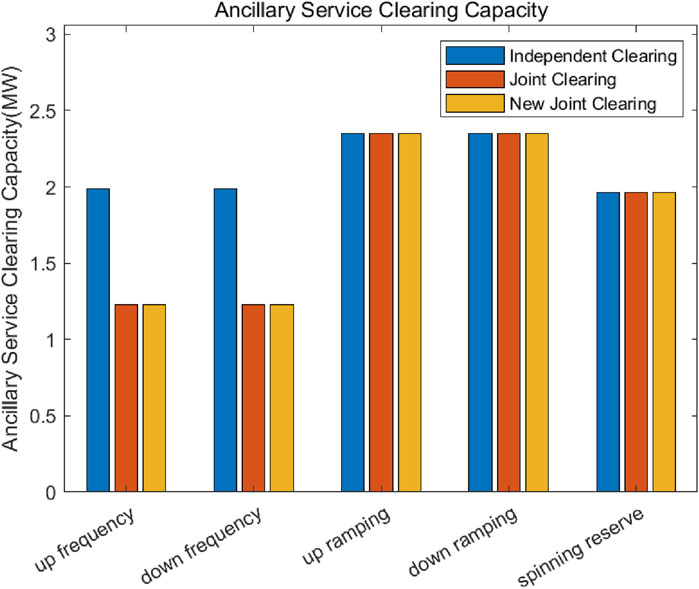
Figure 4. Ancillary service clearing capacity for the three clearing methods when market resources are abundant.
The results of the three clearing methods of electric energy clearing are shown in Figure 5.
As shown in Figure 5, the two joint clearing methods show consistency in terms of electric energy winning bids. The main difference between independent and joint clearing, however, is that the startup time of unit 6 in independent clearing is significantly longer. Specifically, in the independent clearing mode, unit 6 is turned on for nine periods, compared to unit 6’s startup time of only three periods in the joint clearing. Further analysis of the unit operating costs reveals that the minimum technical output costs account for a significant proportion. Therefore, when unit 4 is turned on too much in independent clearing, its final total cost will be higher than that in joint clearing.
The root cause of this phenomenon lies in the fact that independent clearing failed to fully consider the coupling relationship between electric energy clearing and ancillary service clearing in the process of formulating (SCUC). In order to ensure the normal clearing of the subsequent ancillary services, independent clearing has to reserve a considerable part of the capacity margin in the formulation of SCUC. However, this reserved capacity margin is often not fully utilized in the subsequent ancillary service clearing, which leads to an increase in cost. In contrast, joint clearing takes the capacity coupling relationship between electric energy and ancillary services into full consideration when formulating SCUC, so it can more effectively avoid unnecessary unit startups and thus achieve cost optimization.
This subsection provides an in-depth analysis with specific examples, and the results show that in an environment of relatively abundant market resources, both types of joint clearing demonstrate superior cost-effectiveness compared to the independent clearing mechanism.
5.2 Clearance by different clearing methods when market resources are scarce
This subsection explores the differences in the clearing results of the three clearing methods under the scenario of market resource scarcity. In order to accurately compare the three clearing methods, this case introduces the virtual unit as the supplement of ancillary services, which can flexibly provide any type of ancillary service with no upper limit, and the offer price of each service is uniformly set at 90,000$/MW. Based on this setup, we arrive at the cost comparison diagrams of the three clearing methods shown in Figure 6. The ancillary service clearing capacity of the three clearing methods is shown in Figure 7, and the ancillary service capacity shortage is shown in Figure 8.
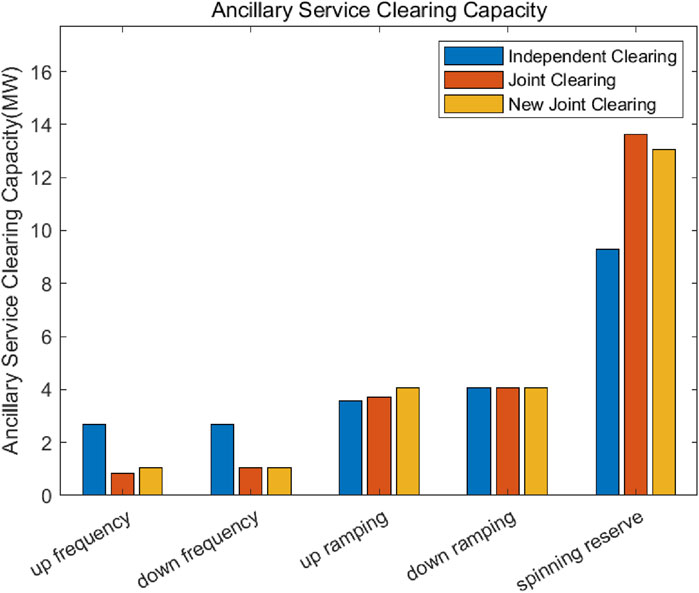
Figure 7. Ancillary service clearing capacity for the three clearing methods when market resources are scarce.
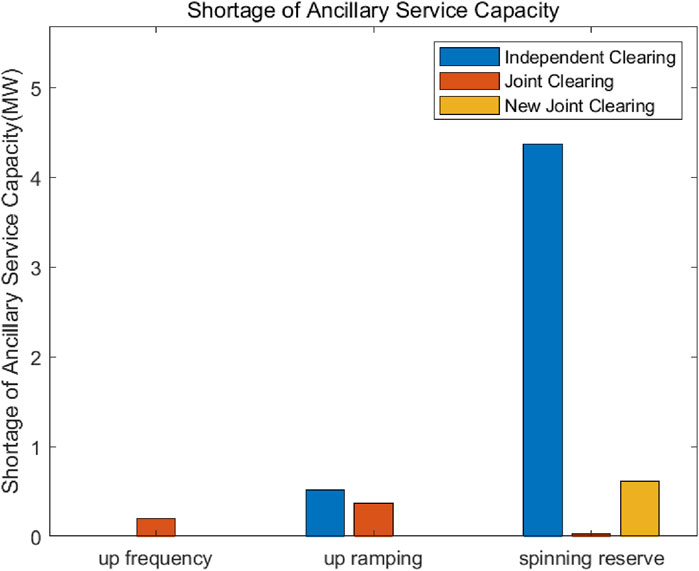
Figure 8. Ancillary service capacity shortage for three clearing methods when market resources are scarce.
The cost of clearing is analyzed for the three clearing methods. Figure 6 shows that among the three types of clearing, independent clearing has the highest total cost, the lowest cost of electric energy, and the highest cost of ancillary services, while the other two types of clearing have approximately the same costs. The reason for this result is that when the demand for system ancillary services increases, the energy market should increase the capacity margin of the units, but independent clearing still maintains the original capacity margin. Therefore, the capacity margin that is in excess in the market with abundant resources is in shortage in the market with scarce resources, which, on one hand, results in the cost of electric energy of independent clearing being lower than that of joint clearing and, on the other hand, results in the shortage of ancillary services of independent clearing being much larger than that of joint clearing. The shortage under independent clearing is much larger than that of joint clearing, as shown in Figures 7, 8, and these shortages need to be supplemented by high-priced virtual units, which, in turn, results in the clearing cost of independent clearing ancillary services to be significantly higher than those of the other two clearing methods, ultimately leading to the highest total cost for independent clearing.
The capacity shortage of the three clearing methods is analyzed. As shown in Figure 8, independent clearing has a capacity shortage in the ramping and spinning reserve markets; traditional joint clearing has a capacity shortage in the frequency regulation, ramping, and spinning reserve markets; and joint clearing considering weights has a capacity shortage only in the spinning reserve market.
As shown in Figures 7, 8, the frequency regulation market can still be cleared even if there is a significant capacity shortage in the system ancillary services, which further confirms the targeting of resource allocation in independent clearing. In contrast, the traditional joint clearing model lacks a clear focus when considering ancillary services, resulting in a capacity shortage in all ancillary service markets. While the capacity shortage in traditional joint clearing may not be significant in aggregate terms, its wide distribution reveals a lack of targeting; joint clearing considering the weights of ancillary services, on the other hand, sets weighting factors for each type of ancillary service, resulting in a similarly focused clearing. The fact that the approach shows capacity shortage only in the spinning reserve market reflects the precision and targeting of its resource allocation.
In scenarios where market resources are scarce, joint clearing considering the weights of ancillary services shows unique advantages. On one hand, it is able to optimize the total cost of clearing, as in the case of traditional joint clearing, and on the other hand, it ensures that the outcome of clearing has a clear focus, as in the case of stand-alone clearing. Therefore, it can be concluded that joint clearing considering the weights of ancillary services combines the advantages of the other two types of clearing, thus maximizing cost-effectiveness and ensuring rational and targeted allocation of resources.
5.3 Clearance by joint clearing when weighting factor
This subsection analyzes the role of weighting factor
As shown in Figure 9, with an increase in
As shown in Figure 11, the overall ancillary service capacity shortage of the system remains constant under different
The weighting parameters
This subsection highlights how the setting of the weighting factor
6 Conclusion
This paper focuses on designing and constructing a joint clearing model that considers the weights of ancillary services. On one hand, the model inherits the traditional advantages of joint clearing, including the minimization of overall costs and the effective consideration of the capacity coupling relationship among markets to ensure the optimal allocation of resources; on the other hand, it also incorporates the beneficial qualities of independent clearing, i.e., in the event of a shortage of resources in the market, it can ensure that electric energy and key ancillary services (e.g., frequency regulation ancillary services) are cleared normally and make the clearing results more targeted and prioritized. This joint clearing model finally realizes the joint clearing of different trading varieties, such as energy, frequency regulation ancillary service, spinning reserve ancillary service, and ramping ancillary service. Compared with the independent clearing model, the model shows significant advantages in reducing the cost of power generation through the verification of actual cases. At the same time, compared with the traditional joint clearing model, it can more effectively respond to extreme situations such as market resource shortages and ensure that the key services of the power system are prioritized under resource-limited conditions. In addition, the model makes the clearing results more focused through refined weight settings, providing a strong guarantee for the safe and stable operation of the power system.
Although this paper has carried out an in-depth study of the joint clearing model, there are some shortcomings in the subtle aspects involving the specific clearing process; therefore, future research can focus on further exploring and optimizing the clearing mechanism. On one hand, the specific impact of different weighting parameters on the joint clearing results can be studied in depth, and on the other hand, attention can be paid to finding ways to maintain the stability and adaptability of the joint clearing mechanism in the complex and volatile power market environment.
Data availability statement
The original contributions presented in the study are included in the article/supplementary material; further inquiries can be directed to the corresponding author.
Author contributions
DM: writing – original draft and writing – review and editing. MC: writing – original draft and writing – review and editing. QL: writing – original draft and writing – review and editing. YY: writing – original draft and writing – review and editing. ZW: writing – original draft and writing – review and editing. XZ: writing – original draft and writing – review and editing.
Funding
The author(s) declare that financial support was received for the research and/or publication of this article. This work was supported in part by the Science and Technology Projects of Guangxi Power Grid Corporation (No. 046000KK52222033).
Conflict of interest
Authors MD, CM, LQ, and YY were employed by the Power Dispatching Control Center of Guangxi Power Grid Co., Ltd. Author WZ was employed by the Guangxi Power Grid Co., Ltd.
The remaining authors declare that the research was conducted in the absence of any commercial or financial relationships that could be construed as a potential conflict of interest.
The authors declare that this study received funding from Guangxi Power Grid Corporation. The funder had the following involvement in the study: study design, data collection and analysis, interpretation of results, writing of the manuscript, the decision to submit for publication.
Generative AI statement
The author(s) declare that no Generative AI was used in the creation of this manuscript.
Publisher’s note
All claims expressed in this article are solely those of the authors and do not necessarily represent those of their affiliated organizations, or those of the publisher, the editors and the reviewers. Any product that may be evaluated in this article, or claim that may be made by its manufacturer, is not guaranteed or endorsed by the publisher.
References
Chen, D. (2016). Research of new ancillary service market with energy storage participation[D]. Beijing: North China Electric Power University.
Chen, Q., Wu, M., Liu, Y., Wang, Y., Xie, M., and Liu, M. (2021). Joint operation mechanism of spot electric energy and ancillary service for wind power market-oriented accommodation. Electr. Power Autom. Equip. 41 (3), 179–188. doi:10.16081/j.epae.202101026
Csereklyei, Z., Qu, S., and Ancev, T. (2019). The effect of wind and solar power generation on wholesale electricity prices in Australia. Energy Policy 131, 358–369. doi:10.1016/j.enpol.2019.04.007
Dai, J., Tian, S., Zhao, Q., Shan, K., Zhang, Y., and Hong, B. (2023). “Generation schedule generation method based on joint clearing of electric energy and operational reserve,” in 2023 IEEE 7th conference on energy internet and energy system integration (EI2). Hangzhou, China, 459–464.
Ding, Q., Ren, Y., Hu, X., Zou, P., Yan, Z., Li, M., et al. (2021). Design and practice of joint optimization mechanism for spot market and deep peak shaving regulation market of Shanxi in China. Power Syst. Technol. 45 (6), 2219–2227. doi:10.13335/j.1000-3673.pst.2020.2291
Dongsheng, H., Wu, Y., Lyu, X., and Jiang, N. (2019). Optimization model for combined electricity spot and ancillary service markets considering variable generation resources. Power Demand side Manag. 21 (06), 30–34+43. doi:10.3969/j.issn.1009-1831.2019.06.007
Jialong, L., Chen, Y., Liu, S., Zhang, X., Ma, Z., and Zhong, H. (2019). Mechanism design of day ahead market considering deep peak regulation. Automation Electr. Power Syst. 43 (4), 9–1578. doi:10.7500/AEPS20180806011
Jiang, J., Teng, X., Xie, W., Zhang, Y., and Tu, M. (2020). “Joint cleaning model of energy and ancillary service market considering wind power cost,” in 2020 IEEE sustainable power and energy conference (iSPEC). Chengdu, China, 1133–1139.
Liu, X., Zhao, S., Bo, M., Zheng, H., Cheng, X., Zou, P., et al. (2025). Research on sequential market clearing and joint market clearing under different load conditions[J/OL], 1-9. Beijing, China: Journal of North China Electric Power University. Available online at: http://kns.cnki.net/kcms/detail/13.1212.TM.20230425.1148.002.html.
Lv Jun (2022). Research on clearing optimization of day-ahead energy market and joint markets[D]. Fuzhou, Fujian: Fuzhou University. doi:10.27022/d.cnki.gfzhu.2022.000520
Nosair, H., and Bouffard, I. S. (2017). “Energy-centric flexibility management in power systems[C],” in 2017 IEEE power and energy society general meeting: PESGM 2017, Chicago, Illinois, USA, 16-20 july 2017. Institute of Electrical and Electronics Engineers, 1.
Pan, Mengqi (2020). Research of Mechanisms of Day-ahead peak regulation and frequency modulation ancillary service markets with large-scale wind power[D]. Harbin, Heilongjiang: Harbin Institute of Technology. doi:10.27061/d.cnki.ghgdu.2020.000111
Walawalkar, R., Blumsack, S., Apt, J., and Fernands, S. (2008). An economic welfare analysis of demand response in the PJM electricity market. Energy Policy 36 (10), 3692–3702. doi:10.1016/j.enpol.2008.06.036
Wang, Z., Xu, H., Liu, X., and Liu, Z. (2022). Bidding strategy of wind and energy storage with multi-mode in the energy and frequency modulation market. Power capacitor and React. power Compens. 43 (1), 173–179. doi:10.14044/j.1674-1757.pcrpc.2022.01.024
Wu, Y., Wang, J., Peng, C., Chen, C., Dai, X., and Wang, J. (2023). “Joint energy and frequency regulation market clearing considering wind power uncertainty,” in 2023 IEEE/IAS industrial and commercial power system asia (I&CPS asia). Chongqing, China, 1553–1558.
Xuan, Z., Bai, Y., Sun, G., Zou, J., Xuan, P., and Xie, Z. (2019). “A joint clearing model of energy and ancillary service market considering flexible load,” in 8th renewable power generation conference (RPG 2019). Shanghai, China, 1–6.
Yunpeng, WIAO, and Wang, X. (2015). Two-part compound bidding mode for wind power considering low-carbon benefit. Automation Electr. Power Syst. 39 (05), 41–46+74. doi:10.7500/AEPS20140117005
Zhang, M., Zhang, N., Wu, Z., Gao, J., Xu, X., Li, J., et al. (2022). Joint clearing model of day-ahead energy market and down regulation service market for accommodation of renewable energy. Electr. Power 55 (2), 138–144. doi:10.11930/j.issn.1004-9649.202101059
Zhang, N., Zhang, M., Song, K., Xu, X., Zhang, Y., and Lyu, Q. (2021). Day ahead production decision model of flexible combined heat and power enterprises under energy and down-regulation market. ThermalPowerGeneration 50 (3), 106–113. doi:10.19666/j.rlfd.202011274
Zou, J. (2020). Modeling and simulation of Guangdong frequncy regulation market based on multi-agent[D]. Beijing: North China Electric Power University.
Appendix A
Nomenclature
Keywords: joint clearing, electrical ancillary services, security-constrained unit commitment, security-constrained economic dispatch, renewables
Citation: Mo D, Chen M, Li Q, Yang Y, Wang Z and Zhu X (2025) Research on joint clearing of energy and ancillary service in the day-ahead market considering the weights of ancillary services. Front. Energy Res. 13:1583300. doi: 10.3389/fenrg.2025.1583300
Received: 25 February 2025; Accepted: 28 May 2025;
Published: 22 July 2025.
Edited by:
Yingjun Wu, Hohai University, ChinaCopyright © 2025 Mo, Chen, Li, Yang, Wang and Zhu. This is an open-access article distributed under the terms of the Creative Commons Attribution License (CC BY). The use, distribution or reproduction in other forums is permitted, provided the original author(s) and the copyright owner(s) are credited and that the original publication in this journal is cited, in accordance with accepted academic practice. No use, distribution or reproduction is permitted which does not comply with these terms.
*Correspondence: Zhu Xuefeng, cGlnZ3kxMjIyQDE2My5jb20=
 Dong Mo1
Dong Mo1 Xuefeng Zhu
Xuefeng Zhu
